The Sleeving Machines Market is estimated to be valued at USD 3.1 billion in 2025 and is projected to reach USD 4.3 billion by 2035, registering a compound annual growth rate (CAGR) of 3.4% over the forecast period.
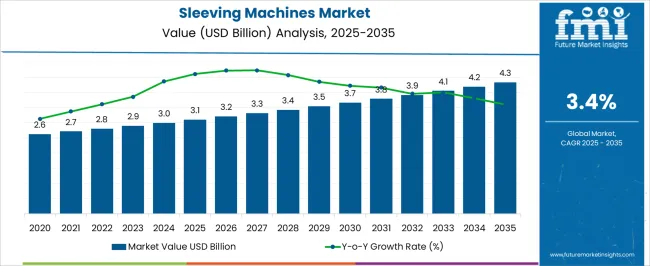
| Metric | Value |
|---|---|
| Sleeving Machines Market Estimated Value in (2025 E) | USD 3.1 billion |
| Sleeving Machines Market Forecast Value in (2035 F) | USD 4.3 billion |
| Forecast CAGR (2025 to 2035) | 3.4% |
The sleeving machines market is experiencing steady growth as industries increasingly focus on automation, efficiency, and product branding. Rising demand for packaged food and beverages, pharmaceuticals, and personal care products has accelerated the adoption of sleeving machines due to their ability to provide tamper evident seals, enhanced labeling aesthetics, and product protection.
Technological advancements in high speed labeling and integration with digital printing are improving flexibility and throughput in production environments. Regulatory emphasis on product safety and clear labeling is also driving adoption across multiple industries.
The market outlook remains positive with opportunities in sustainable sleeve materials, customization, and automation driven solutions that enhance both branding and compliance.
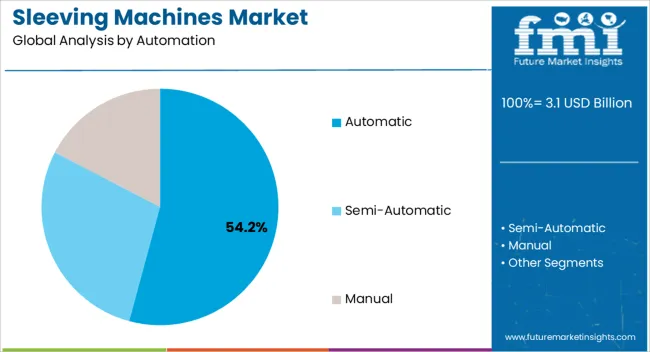
The automatic segment is projected to contribute 54.20% of total revenue by 2025 within the automation category, positioning it as the dominant choice. This share is supported by the increasing focus on production efficiency, reduced downtime, and the ability to handle high speed operations.
Automatic systems have been favored for their consistency, accuracy, and adaptability to diverse packaging formats. Their role in reducing labor dependency while ensuring precision labeling has further strengthened their adoption.
With industries prioritizing cost efficiency and scalability, automatic machines have emerged as the preferred automation solution.
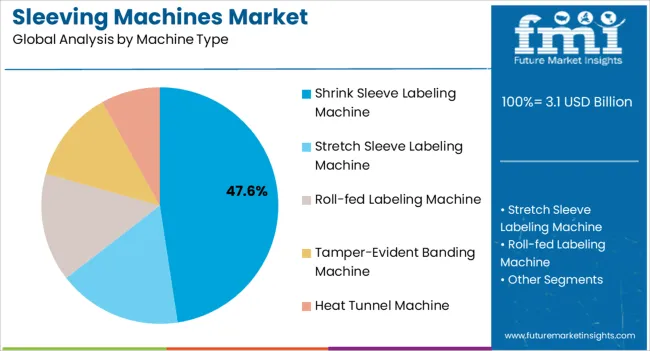
The shrink sleeve labeling machine segment is expected to hold 47.60% of total revenue by 2025 within the machine type category, making it the leading format. This dominance is driven by its ability to deliver 360 degree product coverage, superior branding potential, and tamper evidence.
Demand has been accelerated by the food and beverage sector where shelf appeal and product differentiation are critical. The flexibility of shrink sleeve labeling to accommodate different container shapes and sizes has reinforced its leadership.
As consumer preferences continue to shift toward visually appealing and secure packaging, this machine type maintains its market prominence.
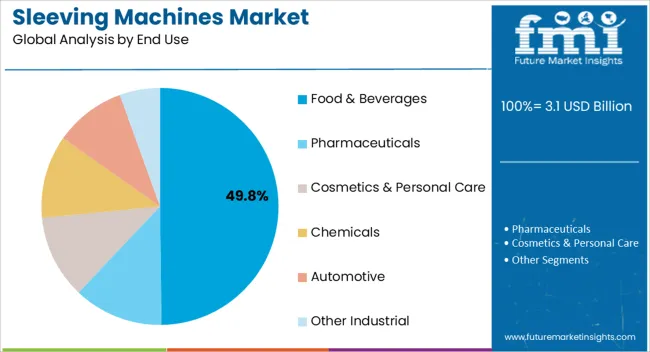
The food and beverages segment is projected to account for 49.80% of total revenue by 2025 within the end use category, making it the most significant contributor. Growth is attributed to rising demand for packaged products, increased consumption of ready to drink beverages, and brand strategies focusing on product differentiation.
Regulatory requirements for labeling accuracy and tamper evidence have also supported strong adoption in this sector. Additionally, the ability of sleeving machines to provide premium shelf presentation and product safety has further boosted their utilization.
This end use continues to dominate due to its consistent demand, large production volumes, and high standards for packaging aesthetics and compliance.
From 2020 to 2025, the global sleeving machines industry experienced sluggish growth at a CAGR of 1.9%. It reached a valuation of USD 3.1 billion in 2025.
From 2020 to 2025, the global market witnessed slow but steady growth due to rising demand for safe and secure seals on packaging during storage & transportation. Increasing awareness about tamper-evident attributes is another factor that pushed the market forward. Customization offered by sleeving machine manufacturers further led to their widespread adoption across the globe.
The global market for sleeving machines is expected to flourish at a CAGR of 3.4% from 2025 to 2035. The market is estimated to expand at a moderate pace amid increased digitalization in the world.
Various leading manufacturers are developing sleeving machines that can be connected to the internet or digital app. This would enable users to communicate & coordinate speed, turn-around time, and maintain running time.
Such features can help to improve the efficiency and productivity of the entire sleeving process. The market is also likely to witness significant growth in Asia Pacific due to the presence of developing economies such as China and India.
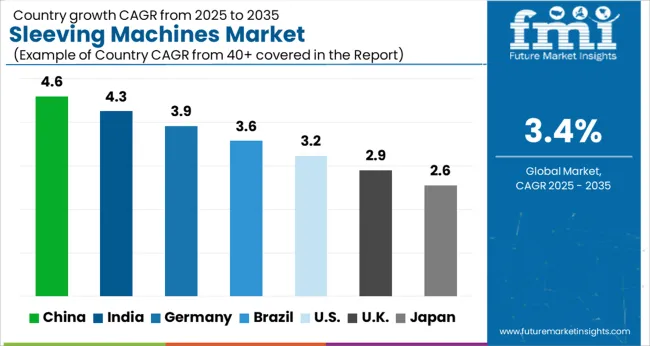
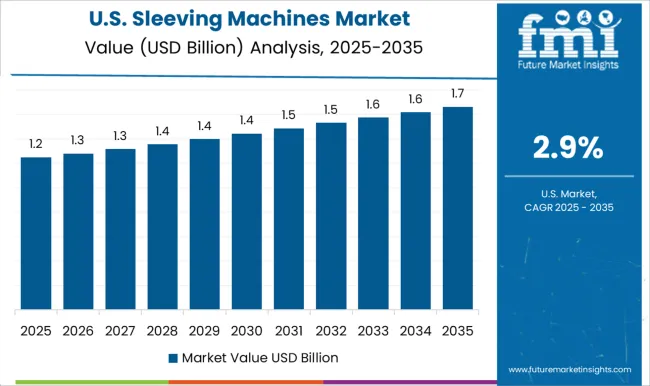
Pharmaceutical Companies in the United States to Look for Advanced Sleeve Shrinking Machines
| Country | The United States |
|---|---|
| Estimated Market Size (2035) | USD 4.3 million |
| Value-based CAGR (2025 to 2035) | 3.1% |
The United States' sleeving machines industry is estimated to reach a valuation of USD 4.3 million by 2035. It is projected to create an incremental opportunity of USD 231.1 million in the next ten years.
As sleeving machines are increasingly being used to print on pharmaceutical packaging, their demand in the United States is expected to witness steady growth. The country is home to one of the largest pharmaceutical markets in the world, and this factor would bode well for the industry.
Rising Demand for Automation in Japan to Fuel Sales of Sleeve Printing Machines by 2035
| Country | Japan |
|---|---|
| Estimated Market Size (2035) | USD 237.8 million |
| Value-based CAGR (2025 to 2035) | 2.3% |
he sleeving machines industry in Japan is estimated to cross a valuation of USD 237.8 million by the end of 2035, expanding 1.2 times its current size. Key players in the country are known for their focus on high-quality products.
Sleeving machines with advanced technology that can deliver precise, high-quality printing, and product handling are gaining momentum in the country. Due to excessive shortage of labor in Japan, automation in packaging operations is also contributing to growth in the country’s sleeving machines industry.
Demand for Automatic Sleeve Sealing Machines to Expand Worldwide through 2035
The automatic segment in terms of automation is set to bolster the sleeving machines market at a CAGR of 3.9% from 2025 to 2035. Automatic sleeving machines provide a high level of automation and efficiency to the sleeving process.
These machines can automatically initiate feeding, cutting, and applying shrink sleeves to containers. They can eliminate the need for manual labor and cut down costs for the same. These machines are also widely known to be more precise and produce results with minimal variation, which is escalating their demand.
Demand for Tamper-evident Sleeve Cutting Machines to Rise with Availability of Counterfeit Products
Tamper evident labels are designed to offer an easy opening method while featuring a tab, wrap, or seal. These provide a visual indication if the product has been opened. This feature is especially crucial for industries such as food, beverage, and pharmaceuticals where health of the consumer might be compromised due to consumption of a tampered product.
Such an attractive attribute is fueling the popularity of tamper-evident banding machines. They deliver increased product safety and security.
Consumers are becoming more aware of the risks associated with counterfeit and tampered products. They are increasingly looking for products that have been verified as safe and authentic. They are hence pushing renowned players in the sleeving machines industry to focus more on producing tamper-evident banding machines.
Food & Beverage Manufacturers to Create High Demand for Automatic Sleeving Machines
The food & beverage industry is considered to be the most prominent end user of sleeving machines in the world. Its wide range of labeling demands is fulfilled by these machines.
Sleeving machines are used in the beverage packaging sector to apply sleeves to bottles & cans that contain beverages such as soda, juice, beer, and wine. These machines can also be used for packaging food products such as snacks, sauces, and condiments packed in different types of containers.
Sleeving machines can apply sleeves to various packaging material substrates such as glass, plastic, and metal containers. These can further create a seamless and visually attractive label for the product, which would propel their demand.
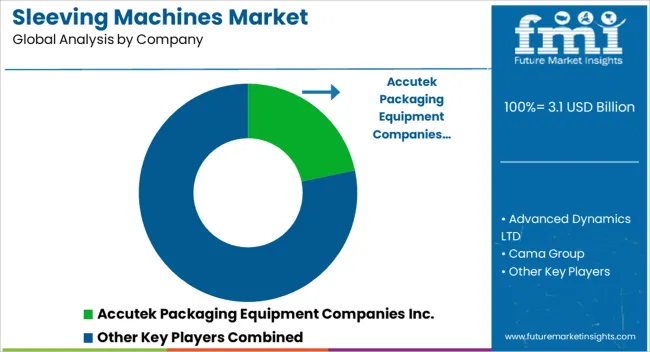
The sleeving machines market is highly competitive and characterized by the presence of several key players offering a wide range of products & services. These companies strive to gain a competitive edge through innovation, technological advancements, product diversification, and strategic partnerships.
Product Innovation Driven by High Demand
Sleeving machine manufacturers are pinning more focus on developing new product offerings, with a spotlight on tamper-evident banding machines. These are gaining speedy popularity across the globe.
Investment in Research and Development
Key players in the sleeving machines industry are investing heavily in their research & development departments. They aim to offer faster and more efficient equipment at an affordable cost for consumers, further driving sales of their products.
Expansion into Emerging Markets
The global market is witnessing growth at a fast pace in emerging economies such as Brazil, India, and China. Leading players are looking to expand their presence in such markets by opening operational facilities and expanding their distribution networks.
Key developments in the sleeving machines industry:
| Attribute | Details |
|---|---|
| Estimated Market Size (2025) | USD 3.1 billion |
| Projected Market Valuation (2035) | USD 4.3 billion |
| Value-based CAGR (2025 to 2035) | 3.4% |
| FORECAST PERIOD | 2025 to 2035 |
| Historical Data Available for | 2020 to 2025 |
| Market Analysis | Value (USD billion) and Volume (tons) |
| Key Regions Covered | North America; Latin America; Western Europe; Eastern Europe; Central Asia; East Asia; Russia & Belarus; Balkan & Baltic Countries; The Middle East & Africa; and South Asia & Pacific |
| Key Countries Covered | United States, Canada, Germany, United Kingdom, France, Italy, Spain, Russia, China, Japan, South Korea, India, Thailand, Malaysia, Indonesia, Australia, New Zealand, GCC countries, and South Africa |
| Key Market Segments Covered | By Automation, By Machine Type, By End Use, By Region |
| Key Companies Profiled | Accutek Packaging Equipment Companies Inc.; Advanced Dynamics LTD; Cama Group; Sleeve Technology BV; PDC International Corporation; Baltic Packaging Systems OU; Allen Plastic Industries Co., Ltd.; AgriNomix LLC; Graphic Packaging International; American Film & Machinery; Axon, LLC; Karlville Development, LLC; Krones AG; Barry-Wehmiller Companies, Inc. |
| Report Coverage | Market Forecast, Company Share Analysis, Competition Intelligence, Market Dynamics and Challenges, Strategic Growth Initiatives |
The global sleeving machines market is estimated to be valued at USD 3.1 billion in 2025.
The market size for the sleeving machines market is projected to reach USD 4.3 billion by 2035.
The sleeving machines market is expected to grow at a 3.4% CAGR between 2025 and 2035.
The key product types in sleeving machines market are automatic, semi-automatic and manual.
In terms of machine type, shrink sleeve labeling machine segment to command 47.6% share in the sleeving machines market in 2025.






Our Research Products

The "Full Research Suite" delivers actionable market intel, deep dives on markets or technologies, so clients act faster, cut risk, and unlock growth.

The Leaderboard benchmarks and ranks top vendors, classifying them as Established Leaders, Leading Challengers, or Disruptors & Challengers.

Locates where complements amplify value and substitutes erode it, forecasting net impact by horizon

We deliver granular, decision-grade intel: market sizing, 5-year forecasts, pricing, adoption, usage, revenue, and operational KPIs—plus competitor tracking, regulation, and value chains—across 60 countries broadly.

Spot the shifts before they hit your P&L. We track inflection points, adoption curves, pricing moves, and ecosystem plays to show where demand is heading, why it is changing, and what to do next across high-growth markets and disruptive tech

Real-time reads of user behavior. We track shifting priorities, perceptions of today’s and next-gen services, and provider experience, then pace how fast tech moves from trial to adoption, blending buyer, consumer, and channel inputs with social signals (#WhySwitch, #UX).

Partner with our analyst team to build a custom report designed around your business priorities. From analysing market trends to assessing competitors or crafting bespoke datasets, we tailor insights to your needs.
Supplier Intelligence
Discovery & Profiling
Capacity & Footprint
Performance & Risk
Compliance & Governance
Commercial Readiness
Who Supplies Whom
Scorecards & Shortlists
Playbooks & Docs
Category Intelligence
Definition & Scope
Demand & Use Cases
Cost Drivers
Market Structure
Supply Chain Map
Trade & Policy
Operating Norms
Deliverables
Buyer Intelligence
Account Basics
Spend & Scope
Procurement Model
Vendor Requirements
Terms & Policies
Entry Strategy
Pain Points & Triggers
Outputs
Pricing Analysis
Benchmarks
Trends
Should-Cost
Indexation
Landed Cost
Commercial Terms
Deliverables
Brand Analysis
Positioning & Value Prop
Share & Presence
Customer Evidence
Go-to-Market
Digital & Reputation
Compliance & Trust
KPIs & Gaps
Outputs
Full Research Suite comprises of:
Market outlook & trends analysis
Interviews & case studies
Strategic recommendations
Vendor profiles & capabilities analysis
5-year forecasts
8 regions and 60+ country-level data splits
Market segment data splits
12 months of continuous data updates
DELIVERED AS:
PDF EXCEL ONLINE
Lathe Machines Market
Sorter Machines Market Size and Share Forecast Outlook 2025 to 2035
Virtual Machines Market by Type, by Enterprise Size, by Industry & Region Forecast till 2035
Bandsaw Machines Market Growth - Trends & Forecast 2025 to 2035
Wrapping Machines for Handkerchiefs Market Size and Share Forecast Outlook 2025 to 2035
Drilling Machines Market Size and Share Forecast Outlook 2025 to 2035
Spinning Machines Market Size and Share Forecast Outlook 2025 to 2035
Knitting Machines Market Size and Share Forecast Outlook 2025 to 2035
Stamping Machines Market Growth and Outlook 2025 to 2035
Twist Tie Machines Market Size and Share Forecast Outlook 2025 to 2035
Cartoning Machines Market from 2025 to 2035
Flow Wrap Machines Market by Horizontal & Vertical Systems Through 2025 to 2035
Flake Ice Machines Market - Industry Growth & Market Demand 2025 to 2035
Flow Wrap Machines Market Analysis – Size, Share & Industry Trends 2025-2035
Ice Maker Machines Market
Granulator Machines Market Size and Share Forecast Outlook 2025 to 2035
Laminating Machines Market Size and Share Forecast Outlook 2025 to 2035
Anesthesia Machines Market - Size, Share, and Forecast 2025-2035
Nugget Ice Machines Market – Market Innovations & Future Trends 2025 to 2035
Compaction Machines Market Growth - Trends & Forecast 2025 to 2035

Thank you!
You will receive an email from our Business Development Manager. Please be sure to check your SPAM/JUNK folder too.
Chat With
MaRIA